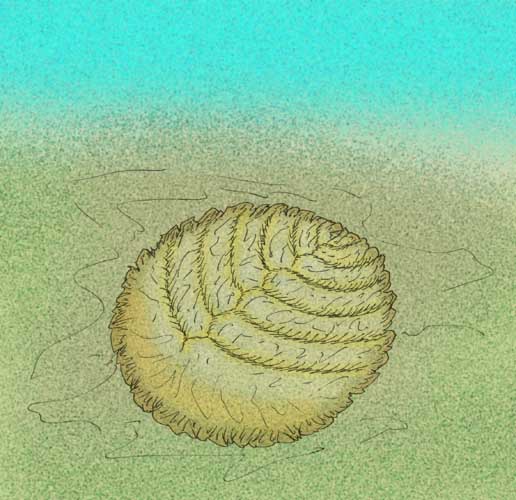Vendiamorpha on:
[Wikipedia]
[Google]
[Amazon]
Vendiamorpha
is a
 The phenomenon of left-right alternating segments is called ''
The phenomenon of left-right alternating segments is called ''
class
Class, Classes, or The Class may refer to:
Common uses not otherwise categorized
* Class (biology), a taxonomic rank
* Class (knowledge representation), a collection of individuals or objects
* Class (philosophy), an analytical concept used d ...
of extinct animals within the Ediacaran
The Ediacaran ( ) is a geological period of the Neoproterozoic geologic era, Era that spans 96 million years from the end of the Cryogenian Period at 635 Million years ago, Mya to the beginning of the Cambrian Period at 538.8 Mya. It is the last ...
phylum
In biology, a phylum (; : phyla) is a level of classification, or taxonomic rank, that is below Kingdom (biology), kingdom and above Class (biology), class. Traditionally, in botany the term division (taxonomy), division has been used instead ...
Proarticulata
Proarticulata is a proposed phylum of extinct, near-bilaterally symmetrical animals known from fossils found in the Ediacaran (Vendian) marine deposits, and dates to approximately . The name comes from the Greek () = "before" and Articulata, i. ...
.
The typical vendiamorph had an oval-shaped or round-shaped body divided completely into segmented isomers
In chemistry, isomers are molecules or polyatomic ions with identical molecular formula – that is, the same number of atoms of each element – but distinct arrangements of atoms in space. ''Isomerism'' refers to the existence or possibili ...
, that were arranged alternately in two rows with reference to the longitudinal axis of the body.
Description
 The phenomenon of left-right alternating segments is called ''
The phenomenon of left-right alternating segments is called ''glide reflection
In geometry, a glide reflection or transflection is a geometric transformation that consists of a reflection across a hyperplane and a translation ("glide") in a direction parallel to that hyperplane, combined into a single transformation. Bec ...
symmetry'', and is a diagnostic feature of proarticulates. Transverse elements decrease in size from one end to the other and are inclined in the same direction. Typically, the first few, or largest initial isomers are fused together to form a headshield-like structure, leading some researchers to have originally considered them to be ancestral or related to arthropod
Arthropods ( ) are invertebrates in the phylum Arthropoda. They possess an arthropod exoskeleton, exoskeleton with a cuticle made of chitin, often Mineralization (biology), mineralised with calcium carbonate, a body with differentiated (Metam ...
s, though, overwhelming evidence of them being proarticulates have since led researchers to discard this hypothetical relationship.
Some vendiamorphs (e.g., ''Vendia'' and ''Paravendia'') supposedly demonstrate a digestive-distributive system consisting of a simple axial tube and lateral appendages, with one lateral appendage corresponding to one isomer. The tentative vendiamorph ''Karakhatia'' is unique from the other members, as well as all proarticulates, in the fact that is has been noted to bearing 'coarse radial folds' around its outer margin, which has given it a noticeably frilly appearance, has been likened to what is seen in material of '' Haootia''.
Taxonomy
Vendiamorpha currently contains the singularFamily
Family (from ) is a Social group, group of people related either by consanguinity (by recognized birth) or Affinity (law), affinity (by marriage or other relationship). It forms the basis for social order. Ideally, families offer predictabili ...
Vendiidae (Originally Vendomiidae, derived from Vedomia, which was later synonymised into Dickinsonia
''Dickinsonia'' is a genus of extinct organism that lived during the late Ediacaran period in what is now Australia, China, Russia, and Ukraine. It had a round, bilaterally symmetric body with multiple segments running along it. It could range f ...
.):
Vendiidae
*† '' Vendia'' Ivantsov, 2001 **† '' Vendia sokolovi'' Keller, 1969 **† '' Vendia rachiata'' Ivantsov, 2004 *† '' Paravendia'' Ivantsov, 2004 **† '' Paravendia janae'' Ivantsov, 2004 *† '' Karakhtia'' ? Ivantsov, 2004 **† '' Karakhtia nessovi'' Ivantsov, 2004 Due to the crumpled nature of most ''Karakhtia'' specimens and the aforementioned presence of coarse radial folds, the placement of it within ''Vendiamorpha'', and ''Proarticulata'' itself, is tentative.Distribution
All members of Vendiamorpha are restricted to the Ust' Pinega Formation of Syuzma andOnega River
The Onega (; ) is a river in Kargopolsky, Plesetsky, and Onezhsky Districts of Arkhangelsk Oblast in Russia. The Onega connects Lake Lacha with the Onega Bay in the White Sea southwest of Arkhangelsk, flowing in the northern direction. The disc ...
s in Arkhangelsk Oblast
Arkhangelsk Oblast ( rus, Архангельская область, p=ɐrˈxanɡʲɪlʲskəjə ˈobɫəsʲtʲ) is a federal subjects of Russia, federal subject of Russia (an oblast). It includes the Arctic Ocean, Arctic archipelagos of Franz ...
, northwestern Russia
Russia, or the Russian Federation, is a country spanning Eastern Europe and North Asia. It is the list of countries and dependencies by area, largest country in the world, and extends across Time in Russia, eleven time zones, sharing Borders ...
.
Name
The clade name '' Pseudovendia'' refers to the resemblances to a fossil imprint described as ''Vendia sokolovi''. Originally, that fossil was interpreted as an arthropod, later as aproarticulata
Proarticulata is a proposed phylum of extinct, near-bilaterally symmetrical animals known from fossils found in the Ediacaran (Vendian) marine deposits, and dates to approximately . The name comes from the Greek () = "before" and Articulata, i. ...
n, then conjectured as possibly a frond-like organism.
Current scientific consensus now recognizes the poorly preserved holotype of ''Pseudovendia'' as a pseudofossil.
See also
*List of Ediacaran genera
The existence of life, especially that of animals, before the Cambrian had long been the subject of debate in paleontology. The apparent suddenness of the Cambrian explosion had no firm explanation, and Charles Darwin himself recognized the chal ...
References
External links
* {{Taxonbar, from=Q7919616 Vendiamorpha Prehistoric animal classes